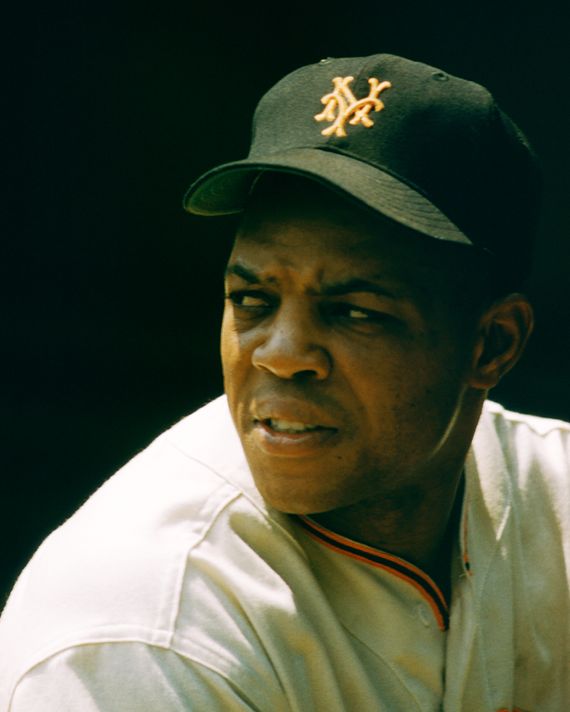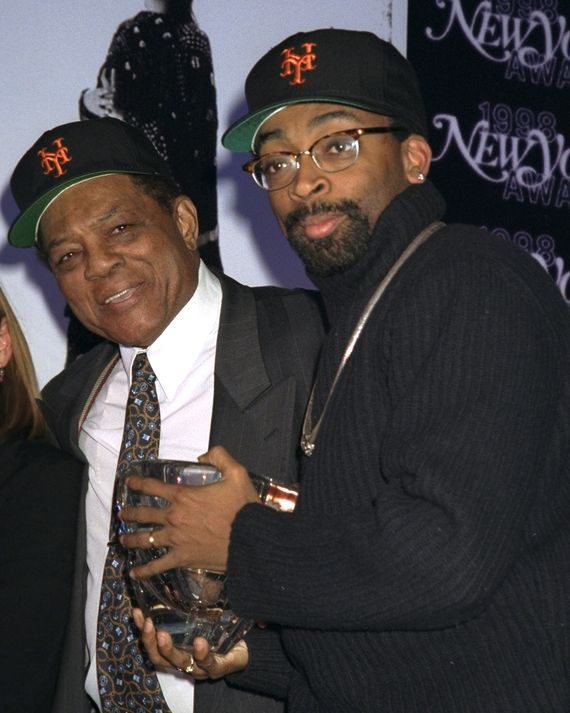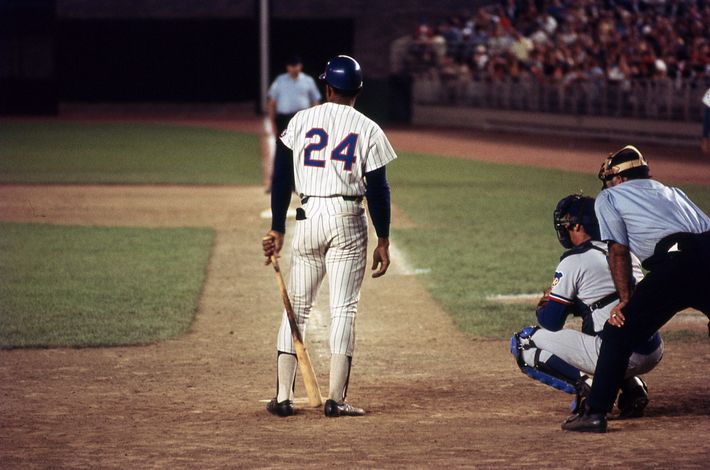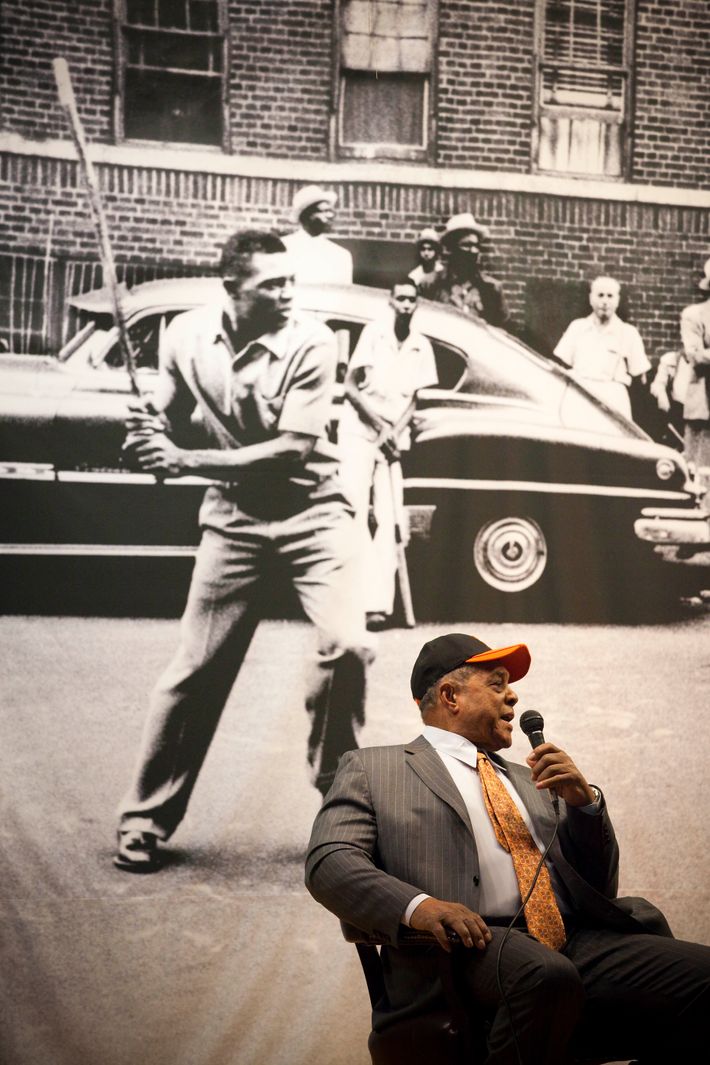

Mays with the New York Giants, 1957.
Photo: Hy Peskin/Getty Images
They’re showing that play a million billion times now. Willie Mays has died, and everywhere you look he is being memorialized with a grainy black-and-white clip, sprinting into deepest center field at the Polo Grounds, catching the ball over his left shoulder and saving game one of the 1954 World Series for the New York Giants. It was the first catch to be capitalized as The Catch. It is now being replayed as the prime illustration of Mays’s greatness, as the greatest catch maybe in baseball history and the greatest catch Mays ever made.
Willie Mays made a greater catch. He told me so. Actually, he told my father to tell me so.
For several years in the late 1990s and early aughts, New York Magazine bestowed annual awards. In 1998, the Lifetime Achievement honor went to Willie Mays. There was a dinner, at Cipriani on West 42nd Street, to celebrate the honorees — well, and to publicize the magazine — and because I’d written the short block of text explaining why we had picked Mays, I got to sit at a table with him. Because my father was a lifelong Mays fan, I made sure he had a seat as well. Mays had a reputation for being cranky, but on this night he was charming. When, inevitably, someone mentioned The Catch, though, a little bit of the irascibility and a lot of pride flashed. “Tell him!” Mays said, turning to my dad. “Tell him! I made better catches!”
Bob Smith was 13 years old in 1951, when Willie Mays made his major-league debut. He lived on Staten Island and had become a Giants fan for the classic reason — because his father was. But Frank Smith had died suddenly of a heart attack a year earlier, shortly after Ruth Smith, Bob’s mother, had died of cancer. The orphaned boy was shipped off to live with an aunt and uncle who treated him miserably. Right about then, Willie Mays arrived with the Giants, and my future father fell in love, regularly riding the Staten Island Ferry to the D train to the Polo Grounds on West 155th Street, a two-hour trip each way. The reward was that he could sit in the summer sun and watch a beautiful young virtuoso.
Yes, Willie made better catches, my father said that night in 1998. There was the time a fly ball was drifting toward right field —
Mays cut him off. He had been nodding and smiling as my dad started the story, but Willie remembered the play, he was the one who had made the play, and now he was the one who was going to tell the story: “I just kept running and running, the ball kept drifting. I caught it across the right-field line in foul ground! Tell him, Bob!”
I have never seen any footage of such a catch. That doesn’t mean I’m doubting what my dad and Willie Mays remembered. It’s simply that film of Mays’s five glorious seasons as a New York Giant is rare. Yes, he went on to have nine more spectacular, well-documented seasons in San Francisco, after the franchise moved west in 1958. But his death, at 93, is one of the last flickers of a very different city and world, one whose essence now exists only in the memory of the people who saw it and lived it.
Mays with Spike Lee at the New York Awards, December 1998.
Photo: Richard Corkery/NY Daily News Archive via Getty Images/NY Daily News via Getty Images
Mays was born in Westfield, Alabama, population 2,000, and by 16 was such a prodigy that on weekends he played for the Birmingham Black Barons of the Negro Leagues. The Boston Red Sox scouts were highly interested — but the Red Sox would become the last major-league franchise to desegregate. Mays instead signed with the New York Giants. At 19, he spent his first season in the organization with Trenton of the Class B Interstate League — where he was the first and only Black player in the eight-team league and endured racist taunts. The next year, 1951, Mays began the season in Minneapolis, where at least he had Black and Latino teammates and where he hit an otherworldly .477 in 35 games. When the call came that Mays was being promoted to the big leagues, he insisted to Leo Durocher, the Giants manager, that he was not ready. They brought him up to the big club anyway.
New York was both intimidating and a relief. Mays went hitless in his first 12 at-bats and broke down crying. The pugnacious Durocher became a father figure whose confidence helped Mays battle through the slump. The Giants found Mays an apartment on St. Nicholas Place, atop a hill just off West 155th Street and within walking distance of the ballpark, that came with a mother figure, Ann Goosby, the landlady, who cooked meals for Mays. Neighborhood kids knocked on his first-floor apartment window and invited him to come out and play. Which he did: hopscotch, basketball, even hide-and-seek. But it was Mays’s participation in stickball that bound him, permanently and lyrically, to a time and place in city life. He played regularly during his first years with the Giants — in the afternoon following night games, in the evening after day games — but it apparently wasn’t until 1954 that a photographer captured Mays, in a short-sleeve polo shirt and slacks, whacking a pink rubber ball five sewers with a broomstick handle. Collier’s magazine ran a four-page photo essay, though the stickball photos were often used to feed patronizing coverage, painting Mays as a man-child with juvenile tastes. But the joy he felt hanging out with kids was genuine and an antidote to his initial loneliness. Mays later claimed that playing stickball was how he learned to hit a curveball. That may even be true. But what’s certain is that he went on to win National League Rookie of the Year in 1951 and, except for spending two years in the Army, never looked back.
Mays had plenty of adult tastes, too. Brooklyn may have been a fierce National League rival, but when the Dodgers were in town at the same time as the Giants, Mays would meet Junior Gilliam, Don Newcombe, and Joe Black at a pool hall around the corner from Roy Campanella’s West 134th Street liquor store. Both were conveniently located near another regular hangout, Smalls Paradise, one of the city’s few Black-owned nightclubs. Mays was a superstar — “He was everything in New York at the time. He was Mr. New York,” Willie McCovey told author John Shea for the book 24 — but one who didn’t call attention to himself, even after leading the Giants to a World Series championship in 1954. He would occasionally go to nightclubs, but unlike his contemporaries Mickey Mantle and Billy Martin, Mays rarely drank alcohol and never had to be extricated from a brawl. The most significant thing that ever happened to him after-hours didn’t generate any headlines: One night at the original Red Rooster, on West 138th Street, the composer Oscar Hammerstein II introduced Mays to the woman who would become his first wife, Marghuerite.
Mays couldn’t have known it then, but his time as a central character in city life came at a turning point for New York as a whole. He was promoted to the Giants when the city was home to three major-league teams, two of which, the Dodgers and the Yankees, were dominant forces both competitively — the latter in the middle of their dynastic run — and socially with Brooklyn’s Jackie Robinson breaking the major-league color barrier in 1947. The mid-’50s emergence of Mays fueled a debate as to which team employed the best center-fielder: Willie, Mickey (Mantle, of the Yankees), or the Duke (Snider, of the Dodgers). Off the field, Mays lived in a Harlem that was enjoying a cultural peak. Yet suburbanization and white flight were accelerating through the decade, trends that would sweep up Mays in 1958 and sever him from the city where he had essentially grown up: The Giants split for San Francisco, along with the Dodgers, who bolted for Los Angeles, enticed by new stadiums and sunshine. Even baseball, as an industry, was starting to lose its status as the national pastime with pro football, a better TV game, rising in prominence.
Mays didn’t want to leave New York, where he was not only revered but at ease. The small-town southern kid — the “Say Hey Kid,” a nickname born from the giddy, high-pitched way that Mays would greet the strangers who were constantly recognizing him — had come to feel at home in the big city. “I didn’t really understand why,” he told GQ, in 2010, of the Giants’ decision to change coasts. “I’ve got to go out there, find a house, I don’t know the people; they don’t know me. All they know about is what they read in the paper.” Dan Klores, a publicist turned filmmaker and playwright who became close with Mays after he had retired from baseball, says the first seven big-league years didn’t simply form the Mays legend and image; they formed the man. “His emotions and memories, and his friendships and his view of himself — that’s all New York,” Klores says. “The city was a really big part of his identity and his confidence and his joy.”
His affection for New York was only deepened by the reception Mays received in his new baseball hometown. The Giants, in the spirit of starting fresh in San Francisco, listed zeros in the record books for all their holdover players, putting Mays — who had hit 187 East Coast home runs — on equal statistical footing with rookies. And the San Francisco papers promoted two slugging rookies, Orlando Cepeda and Willie McCovey, as local heroes, in contrast to Mays, whom they depicted as a New York guy. Even more painfully, Mays believed he had bought a house in San Francisco, only to have the real-estate developer cave to complaints from white neighbors and kill the deal. The mess hit the papers; the mayor got involved; eventually the developer gave in. But Mays was initially booed when he took the field in San Francisco, and he sold the house after two years, moving his family into a brand-new 15-room stone Tudor in New Rochelle.
At bat with the Mets, 1972.
Photo: Walter Leporati/Getty Images
None of it, however, interfered with his brilliance on the field. “Willie Mays’s best season is … every year,” Bill James, who basically invented modern baseball analytics, says in 24. “Just pick one. They’re all great.” The first season out west, Mays showed off his unprecedented combination of power (29 homers) and speed (a league-leading 31 steals). In 1965, he won a National League MVP award by hitting a personal-high 52 home runs, even as the Giants played home games in the cavernous, ferociously windy Candlestick Park, without sacrificing batting average (.317). The numbers piled up across 23 seasons, totaling 660 homers — leaving Mays, when he retired, behind only Babe Ruth and Henry Aaron — and a career .301 batting average. In Wins Above Replacement, the current measure of baseball greatness, Mays ranks third among position players, trailing only Ruth and his own godson, Barry Bonds.
Yet the numbers, awesome as they are, don’t really communicate what separated Mays from mortal superstars. He was listed at a mere five-foot-11 and 185 pounds, but Mays was all muscle and sinew, with a broad back and lightning-fast hands and feet, a combination of strength and speed elevated by unparalleled grace. Great writers tried to capture the evanescent effect. Pete Hamill: “He brought to the playing of baseball a mysterious, almost magical quality that has disappeared from the professional game. Willie Mays brought us joy. All of us. Even those of us who from birth were fanatical acolytes of the secular church of the Brooklyn Dodgers.” Roger Angell: “He runs low to the ground, his shoulders swinging to his huge strides, his spikes digging up great chunks of infield dirt; the cap flies off at second, he cuts the base like a racing car, looking back over his shoulder at the ball, and lopes grandly into third, and everyone who has watched him finds himself laughing with excitement and shared delight.” Still, it was an actress who got off the best line. Tallulah Bankhead: “There have been two geniuses, Willie Mays and Willie Shakespeare.”
But even geniuses get old. At 41, age and injuries had turned Mays into a part-time player. This did not matter to Joan Payson. She had been a minority owner of the New York Giants and had fought the franchise’s move to San Francisco. Five years later, Payson became the majority owner of the Mets, a team created to partially fill the Giants-Dodgers void, and she vowed to someday return Mays to New York. The chance came in 1972; Mays wasn’t making all that much money, but Giants owner Horace Stoneham was looking to cut payroll and traded him to Payson’s Mets in exchange for $50,000 and pitcher Charlie Williams. At first Mays was reluctant: He had wanted to play his entire career with a single franchise. But the Shea Stadium fans rapidly changed his mind. “It was like I was home,” he said in 24. “Like I never left.”
The baseball reunion wasn’t entirely sweet. His younger teammates revered Mays, but the Mets’ manager, Yogi Berra, didn’t want him on the roster. There were embarrassing moments, most infamously when Mays, playing centerfield, lost a fly ball in Oakland’s late-afternoon shadows during game two of the 1973 World Series. Less remembered is that Mays singled in the winning run of that game in the 12th inning. The Mets couldn’t win Mays another championship ring that season. But he ended where he began and where he belonged, in the World Series, playing for New York. And he stayed, buying an apartment in Riverdale, as his garment-district macher pals looked out for him in his later years.
I saw Mays play in person only once. It was 1969, probably, and we were living not far from Philadelphia, so when the Giants came to town to face the Phillies, my father bought tickets. In the Hollywood version, Mays hits a home run. That didn’t happen, but at some point, he struck out. As Mays walked back to the dugout, I supposedly said, “There goes Willie Mays.” Which now sounds to me like a poignant embellishment by a talented writer and storyteller, which my dad was. Unfortunately, I can’t ask him about the truth of that anecdote again; Alzheimer’s took Bob Smith in October 2020. Now Willie’s gone too. Maybe someday I’ll hunt down that photo of the three of us together.
Mays in 2011, with photo of himself playing stickball in the early 1950s near the Polo Grounds.
Photo: Michael Nagle/Getty Images
Source link







